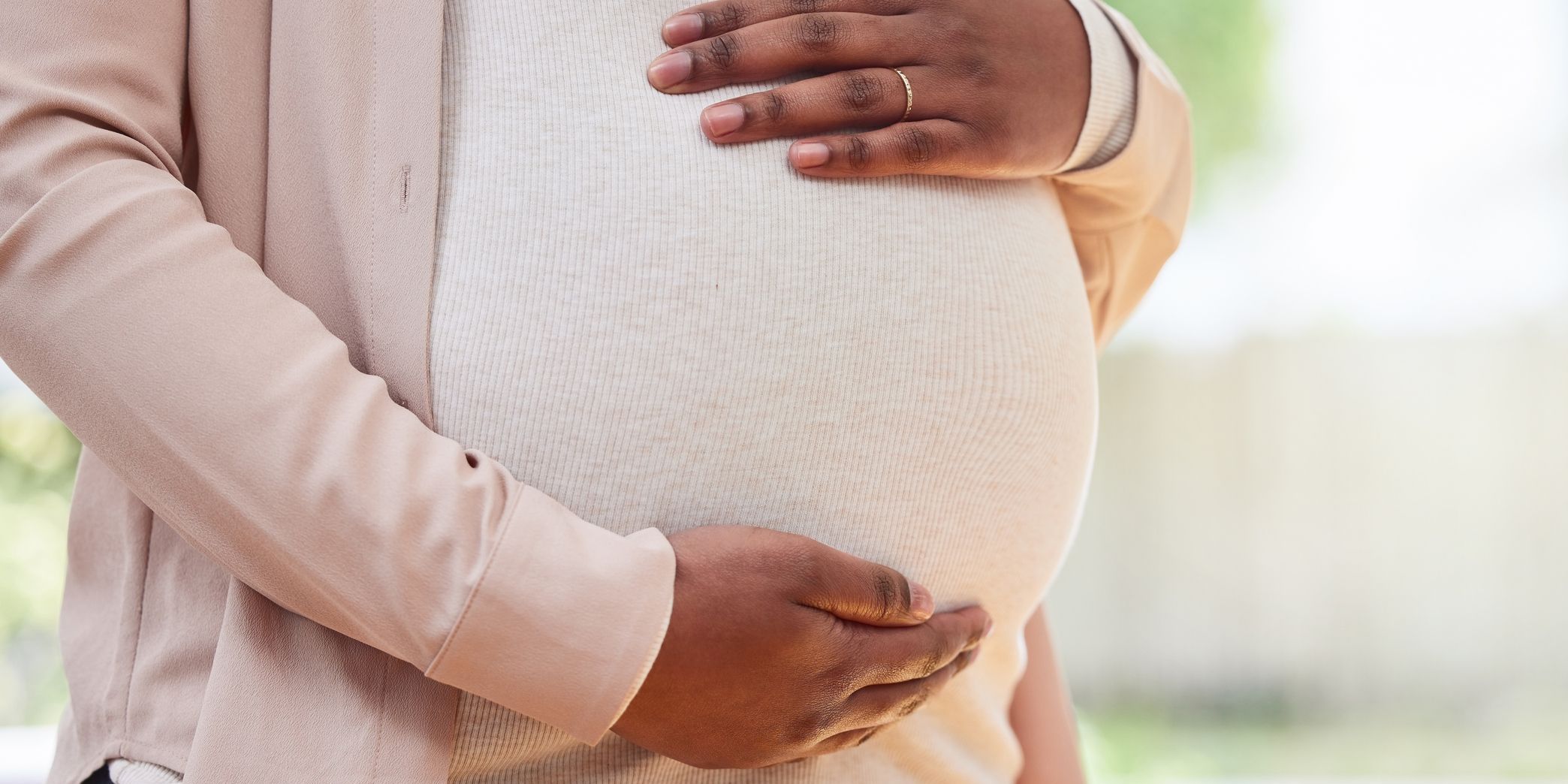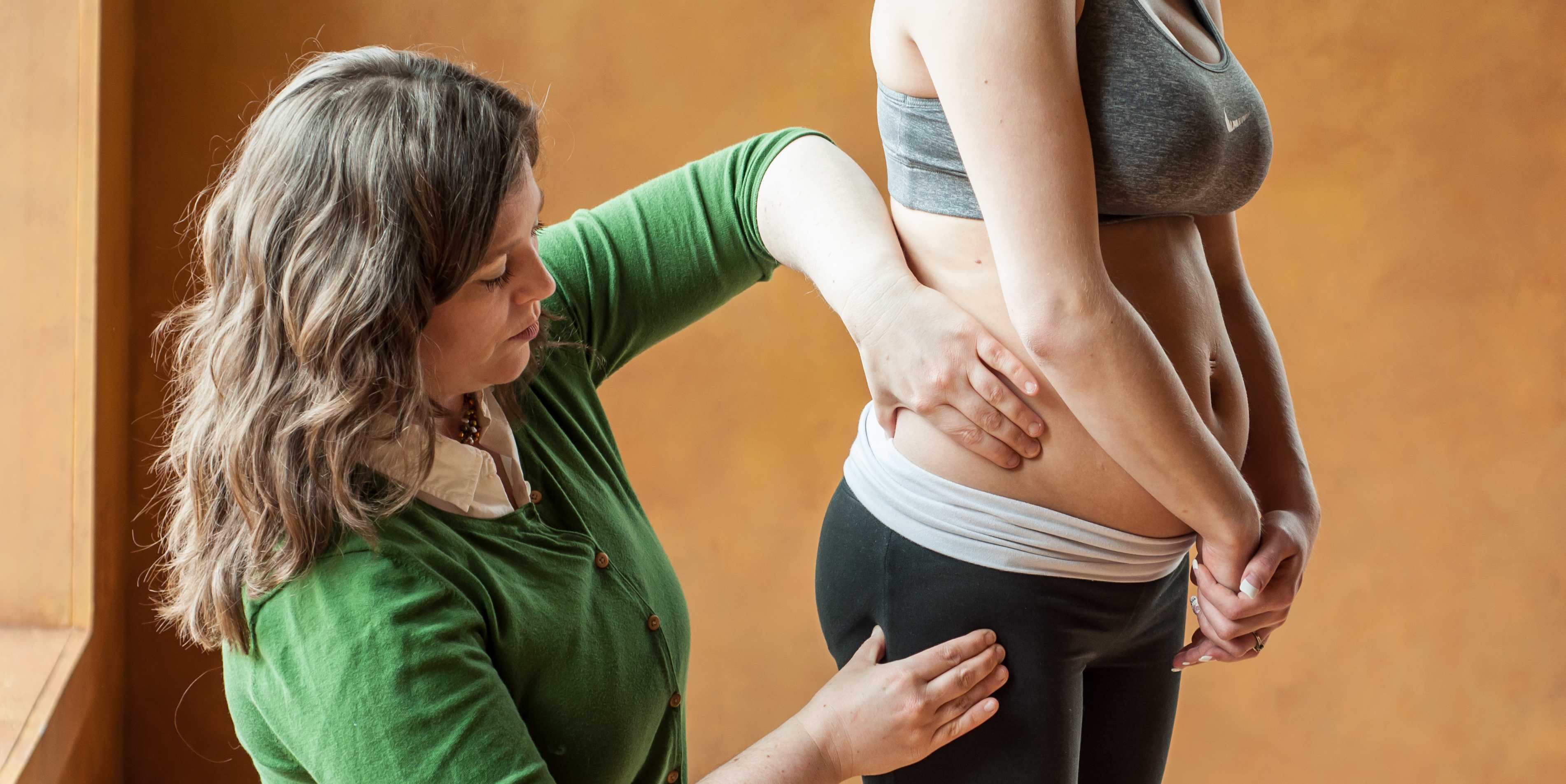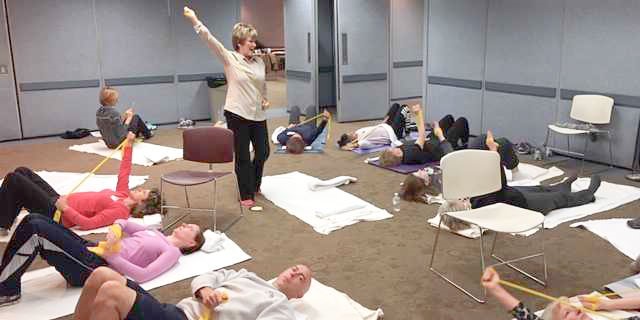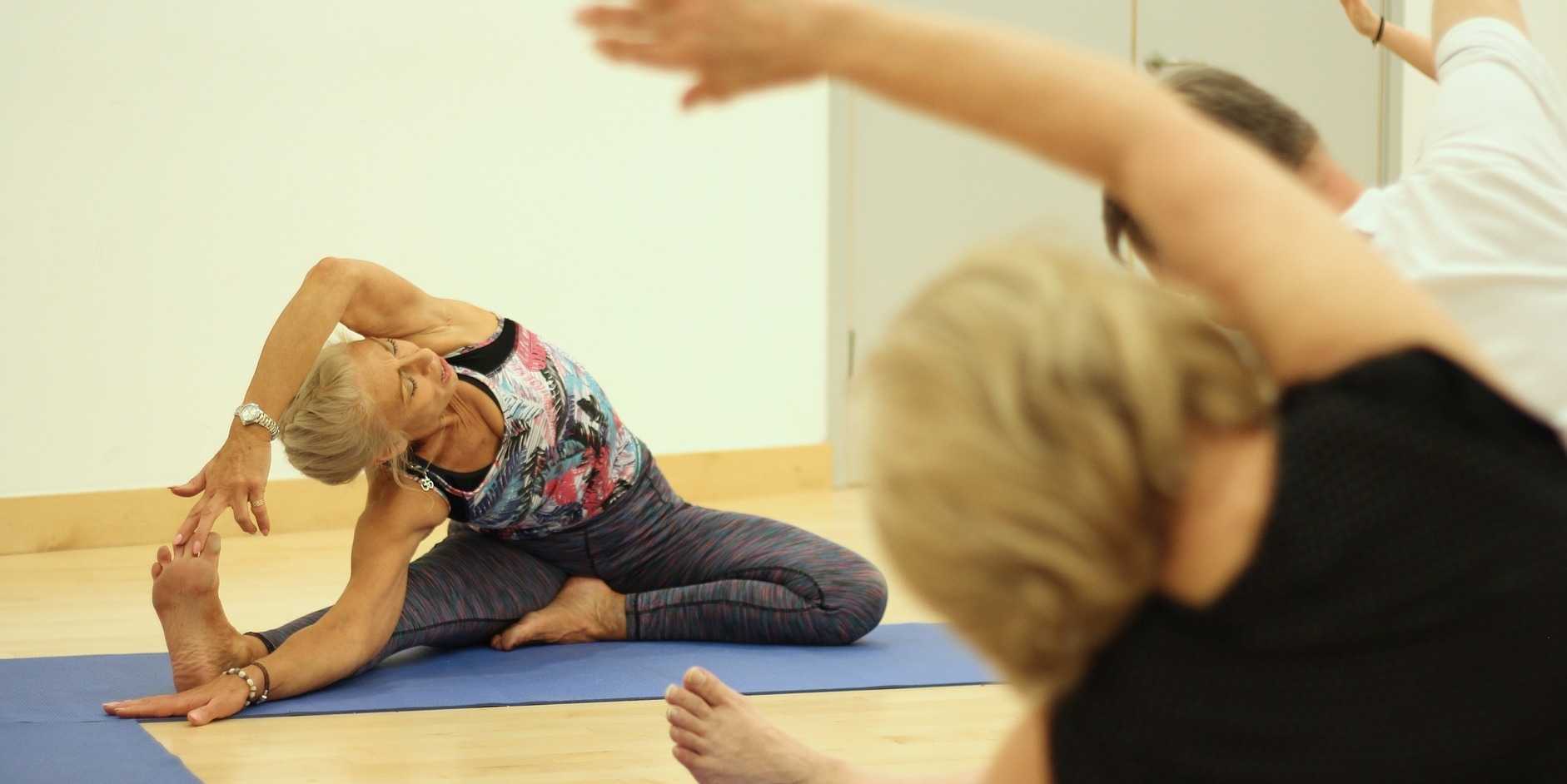The following post comes to us from Herman & Wallace faculty member Allison Ariail, PT, DPT, CLT-LANA, BCB-PMD, PRPC. Allison authored "Use of transabdominal ultrasound imaging in retraining the pelvic-floor muscles of a woman postpartum" and is a leading expert in the use of ultrasound imaging for pelvic rehab. She is the author and instructor of the Rehabilitative Ultrasound Imaging: Women’s Health and Orthopedic Topics offered with Herman & Wallace.
In the pelvic floor series we learn how to perform examinations for cystoceles and rectoceles. It can be more difficult for therapists to examine and quantify the degree of uterine descent. In the last few years translabial ultrasound imaging has also been used to identify what is happening in the anterior compartment upon Valsalva and pelvic floor contraction, including the uterus. This is helpful when trying to determine the degree of uterine prolapse. Degree of pelvic organ descent visible on by ultrasound has been shown to have a near-linear relationship with measures on the POPQ.
Clinically we see that some patients with severe prolapses have few symptoms, while other patients with smaller prolapses will have more severe complaints of symptoms. This can be puzzling to the clinician who is trying to treat prolapse patients. Shek and Dietz performed a study to set cutoff measures of uterine descent that will predict symptoms of prolapse. Translabial ultrasound imaging was performed on 538 women with 263 women reporting prolapse symptoms. Seventy-five percent of the women presented with grade two or greater prolapse on the POPQ, with most of being cystoceles or rectoceles. The women with more complaints of symptoms of prolapse were more likely to have uterine prolapse. There was a strong association between degree of uterine descent and symptoms of prolapse. They determined that an optimal cutoff to predict symptoms of prolapse due to uterine descent is a cervix descending to 15 mm above the pubic symphysis.
The following comes to us from faculty member Allison Ariail. Allison teaches several courses for the Institute, her next one being Rehabilitative Ultrasound Imaging in Baltimore, MD on June 12-14. There is still room, so sign up today!
Living in Colorado, I come across a lot of individuals who are avid runners, cyclists, or triathletes. Even with a higher level of fitness, these individuals will at times have back pain. What is going on in these physically fit, strong individuals? This is what Rostami et al.[1] set out to determine in their recent study. Using ultrasound imaging, they measured the thickness of the transversus abdominis, internal oblique, external oblique, and the cross sectional area of the multifidus while laying down as well as while mounted on a bicycle. They also measured the back strength, endurance, and flexibility of off-road cyclists with and without back pain. Fourteen professional competitive off-road cyclists with low back pain were compared to 24 control. Results showed a significantly thinner transversus abdominis, and cross sectional area of the multifidus muscle in the cyclists with back pain. There was no significant difference found in flexibility or isometric back strength between the two groups. However the cyclists with low back pain demonstrated decreased endurance in back dynamometry with 50% of their maximum isometric back strength.
The results of this study are consistent with other studies that examined less athletic individuals; thinner transverseus abdominis, and smaller multifidus muscles. This further reinforces the training of the local stabilizing muscles. What does this training method consist of? Learning to isolate each of the local stabilizing muscles; the transversus abdominis, the multifidus, and the pelvic floor muscles. Once a patient is able to isolate a contraction, challenge the muscles by holding a contraction while breathing normally, or holding the contraction while performing motor tasks such as Sahrmann’s exercises. Progress the patient so they are able to perform contractions in weight bearing positions and co-contractions of the muscles. Finally, progress the patient to maintaining co-contractions during functional activities and exercise activities. This will improve stability of the back and pelvis as well as decrease the pain experienced by the patient.
Today’s contribution to the Pelvic Rehab Report comes from Allison Ariail, the instructor for Herman & Wallace’s Rehabilitative Ultrasound Imaging courses. Join Allison and others this June 12-14 at Rehabilitative Ultra Sound Imaging: Women's Health and Orthopedic Topics - Baltimore, MD!
Is an Ultrasound that provides images of the pelvic floor and other deep musculature a cool gadget to have in the office or something that is truly essential? That depends on who you are asking! If you know how to use Ultrasound imaging properly and market yourself and your practice accordingly, it can become a tool that is not only fun to have and handy to use clinically, but also essential to providing your most efficient and thorough care!
Using an ultrasound (US) machine allows you to view the deeper musculature to assess how the muscles are functioning. The most common muscles assessed with US imaging are the transverse abdominis, the multifidus, and the pelvic floor. The patient then can use what is seen on the US screen as biofeedback to retrain their strategy and timing of recruitment. The therapist can also assess the patient’s ability to activate and maintain a contraction in various positions and even during motor tasks as well. This type of biofeedback is not only useful for pelvic floor patients, but is also important for patients with back and sacroiliac joint pain. Research is showing that using this type of stabilization program is making a difference in athletes. Julie Hides has published two articles recently showing that this type of stabilization program has helped with low back pain in professional cricket players, as well as to decrease the rate of lower extremity injury in Australian professional football players. (1,2) (see my post on The Local Stabilizing Muscles and Lower Extremity Injury.
Today's post on the Pelvic Rehab Report comes from faculty member Allison Ariail, PT, DPT, CLT-LANA, BCB-PMD, PRPC. Allison instructs the ultrasound imaging courses, the next of which will be Rehabilitative Ultra Sound Imaging: Women's Health and Orthopedic Topics in Baltimore, MD on Jun 12, 2015 - Jun 14, 2015.
In the past several decades there has been quite a bit of research regarding stabilization of the low back and pelvic ring. We as therapists have changed our focus from working more of the global stabilization muscles to the local stabilizing muscles; the transverse abdominis, the lumbar multifidus, and the pelvic floor. Both research studies and clinical experience has shown us what a positive difference working on these muscles can makes for back pain and pelvic ring pain, as well as for the risk of injury in the back and pelvic ring. However, what does it do for risk of injury for the lower limb? In 2014, Hides and Stanton published a study looking at the effects of motor control training on lower extremity injury in Australian professional football players. A pre- and post-intervention trial was used during the playing season of the Australian football league as a panel design. Assessment included magnetic resonance imaging and measurements of the cross-sectional area of the multifidus, psoas, and quadratus lumborum, as well as the change in trunk cross-sectional area due to voluntary contraction of the transverse abdominis muscle. A motor control program included training of the multifidus, transversus abdominis, and the pelvic floor muscles using ultrasound imaging for feedback that then progressed into a functional rehabilitation program was used with some of the players. Injury data was collected throughout the study. Results showed that a smaller multifidus or quadratus lumborum was predictive of lower limb injury during the playing season. Additionally, the risk of sustaining a severe injury was lower for players who received the motor control intervention.
Today's post is written by faculty member Allison Ariail, PT, DPT, CLT-LANA, BCB-PMD, PRPC. You can join Allison in her Rehabilitative Ultrasound Imaging: Women's Health and Orthopedic Topics course, which takes place in Baltimore this year, June 12-14.
Since the mid 1990’s the POP-Q has been used to quantify, describe and stage pelvic organ prolapse. A series of 6 points are measured in the vagina in relation to the hymen. In a recent years, translabial ultrasound imaging has been used to look at the pelvic organs and the pelvic floor. A skilled practitioner can view pelvic floor muscle contractions, as well as Valsalva maneuvers and the effects each of these have on the pelvic organs. For example funneling of the urethral meatus, rotation of the urethra, opening of the retrovesical angle, and dropping of the bladder neck and uterus can be viewed using ultrasound imaging of the anterior compartment during Valsalva maneuvers. Pelvic organ descent seen on ultrasound imaging has been associated with symptoms of prolapse.
In our weekly feature section, Pelvic Rehab Report is proud to present this interview with Herman & Wallace instructor Allison Ariail, PT, DPT, CLT-LANA, PRPC, BCB-PMD
How did you get started in pelvic rehab?
I got started in pelvic rehab by treating and specializing in SIJ and low back dysfunction. I used ultrasound imaging to retrain the local core muscles including the transverse abdominis, lumbar multifidus, and the pelvic floor muscles. In treating these patients, not only did they improve with respects to their back pain, but their incontinence improved as well! I then started getting referrals from doctors for incontinence patients. So I took PF1 and as they say, the rest is history! I know that pelvic rehab is my calling. I am impassioned about this subject and love treating these patients. I also thoroughly enjoy teaching about the pelvic floor and the pelvic ring. I truly feel I am one of the lucky ones to actually love what I do!
This post was written by Allison Ariail, PT, DPT, CLT-LANA, PRPC, BCB-PMD. You can catch Allison teaching the Pelvic Floor Level 1 course in May in Los Angeles.
Dysmenorrhea is the medical term used for painful menstruation. Symptoms usually begin 1 or 2 days before or the first day of menstruation and include headache, low back and thigh pain, abdominal pain, nausea and vomiting, diarrhea, and excessive fatigue. Sixty percent of women suffer from dysmenorrhea, with many of these women being incapacitated for up to 3 days each month due to symptoms. There are two types of dysmenorrhea. Primary dysmenorrhea is menstrual pain that is not caused from another disorder or disease. Secondary dysmenorrhea is menstrual pain that is due to a disorder in the pelvic organs including endometriosis, fibroids, adenomyosis, pelvic inflammatory disease, cervical stenosis, or infection. In the past, treatment approaches for primary dysmenorrhea have included the use of non-steroidal anti-inflammatories, hormonal contraceptives, vitamins, and acupuncture. There have not been many studies that look at how physical activity influences the degree of pain for women with primary Dysmenorrhea. However, clinical experience has shown me that some women who begin exercising regularly decrease their dysmenorrhea symptoms compared to what they previously experienced. So I have done a search to find some studies that address this matter.
A Cochrane review found only one study that used a control group. In this study, the experimental group participated in a 12-week walking or jogging program at 70-80% of heart rate range, 3 days a week for 30 minutes. Moos’ Menstrual Distress Inventory was used to measure outcomes. This was given pre-training, post-training, and during the premenstrual and inter-menstrual phases for the three hormonal cycles measured. There were significant lower scores on the Moos’ Menstrual Distress Inventory during the menstrual phase in the group that participated in exercise compared to the control group. Additionally, there was a negative linear trend in scores over the three observed cycles for the training group with no linear trend seen in the control group.1 So the exercise group lessoned the degree of their symptoms over the three months by participating in the walking program!
This post was written by H&W instructor Allison Ariail PT, DPT, CLT-LANA, BCB-PMD, PRPC, who will be presenting Pelvic Floor Level 2B in Houston at the end of February.
Dyspareunia, or pain during or after intercourse, can be very upsetting and frustrating to a woman. One cause of dyspareunia is vaginal dryness. As estrogen levels decrease, the vaginal tissues can have less moisture, elasticity, and become thinner. This not only can affect postmenopausal women, but also post-partum women, and women who are on estrogen-blocking medication due to cancer or for treatment of fibroids. One of the common and effective treatments for this vaginal dryness includes estrogen creams, or hormone replacement. However, what does a woman do if she is not able to use an estrogen cream, due to an estrogen receptor positive cancer? One possibility is hyaluronic acid. Hyaluronic acid is a substance naturally found throughout connective, epithelial, and neural tissue. You may be more familiar with hyaluronic acid as the substance injected into joints for osteoarthritis. However, there have been some recent published studies comparing the use of hyaluronic acid to estrogen replacement.
In 2011, Ekin et al. published a study comparing the use of hyaluronic acid vaginal tablets with estradiol vaginal tablets. Two groups of postmenopausal women with atrophic vaginitis were studied. One group used estradiol vaginal tablets (n=21) for 8 weeks, while the other group used hyaluronic acid tablets (n=21) for 8 weeks. Outcomes consisted of the degree of vaginal atrophy, vaginal pH, vaginal maturation index, and a self-assessed 4-point scale. Both groups had relief of vaginal symptoms, improved epithelial atrophy, decreased vaginal pH, and increased maturation of the vaginal epithelium. The group on estradiol did have greater improvements, however, it was determined that the hyaluronic acid vaginal tablets was effective enough to be considered an alternative treatment for those who wanted to avoid the use of a local estrogen treatment.
This post was written by H&W instructor Allison Ariail PT, DPT, CLT-LANA, BCB-PMD. Allison will be instructing the Pelvic Floor Level 1 course Boston this October.
Several weeks ago some of my fellow faculty members and I were discussing the resting tone of the pelvic floor. These days we take it for granted that we know there is constant low-level activity in the pelvic floor and anal sphincter in order to provide continence. However, how did this information come about? I took it upon myself to do some research to find out the beginnings of this knowledge. What I found was interesting and thought I would share.
In the late 1940’s and early 1950’s the belief was held that the pelvic floor and external anal sphincters were inactive at rest, like other striated muscle throughout the body. Activity was believed to be initiated by afferent impulses from the rectal ampulla and anal canal. In 1953 Floyd and Walls found activity in the external anal sphincters at rest, even during sleep. In 1962 Parks, Porter, and Melzak published a study examining the pelvic floor muscles and the external anal sphincters using electromyography recordings. They also found activity in these muscles at rest. They hypothesized the activity was maintained by spinal reflex. These researchers looked at the activity in a healthy population, a paraplegic population, and a population that had undergone a rectal excision. When examining the paraplegic population (all subjects had complete SCI injuries above L3), they did identify activity of the pelvic floor at rest.
This post was written by H&W instructor Allison Ariail, PT, DPT, CLT-LANA, BCB-PMD. Allison will be instructing the Care of the Postpartum Patient course in Houston in June.
As Mother’s day weekend approaches, I take time to think about the dramatic changes in life that occur with the birth of a baby! No one is quite prepared for how much their life will change with the birth of their child, especially their first child! There are numerous changes that occur in a woman’s life during the pregnancy and into the postpartum time, both emotionally and physically. Any woman who has had a baby knows our bodies do not revert back to the exact body we had prior to pregnancy. New moms may be left with changes in their body that can greatly affect their function. Physical therapy in the postpartum time can greatly improve a woman’s well-being and function. We can treat a woman for back pain, diastasis rectus separations, incontinence, thoracic outlet syndrome, nerve damage that occurred during delivery, and many more issues a woman may present with. We also are a listening ear for the new mom going through many changes and hormonal upheaval. It is important to stay open and listen in a non-judgmental way. New moms are inundated with unsolicited advice in a way that no other patient population is. Having a safe place to come and get treated physically can help her emotionally as well.
During pregnancy and the postpartum time many habits are formed that if not changed can influence and shape how a woman lives the rest of her life. For example, night time voiding is common for pregnant women. If a woman continues to void every time she gets up with the baby in the middle of the night once she delivers, she may continue or even worsen her habit, thus creating an issue that will greatly affect her overall sleep health and well-being for the rest of her life. Having an objective person educate a woman about some of these habits can be very enlightening for an individual!








































